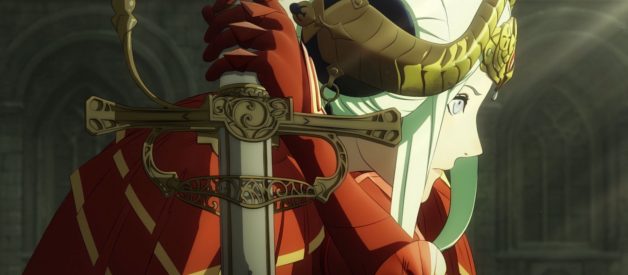 I chose this image from the Nintendo?s site for no particular reason. No particular reason at all.
I chose this image from the Nintendo?s site for no particular reason. No particular reason at all.
One of the most heart-breaking moments in Fire Emblem: Three Houses happens off the battlefield. I was running errands around the main hub, the monastery Garreg Mach, and ran into Dorothea. A former Black Eagle, the house for students from the Adrestian Empire, I had convinced her to join my house, Golden Deer, which was associated with the Leicester Alliance. We began talking about the last battle. It was a mission on a bridge at the border between the Alliance and the Empire, which the Alliance needed to seize to begin a counterinvasion. During this battle one of Dorothea?s former classmates, Ferdinand, rallied to the Empire?s defense. He rode over to me, and after informing me that the Empress, Edelgard, was obsessed with me, he declared that he had to kill me to impress her.
Ferdinand, needless to say, did not end up impressing Edelgard.
I had never liked Ferdinand and his aristocratic haughtiness, so I found his death sad and lamentable in the way that any death is, but it did not leave me with too many conflicted feelings. By contrast, Dorothea was devastated about Ferdinand?s death. ?And Ferdie was there,? she said, ?We killed Ferdie, Professor, he used to be our friend. Do you remember those days?? Dorothea remembered keenly her time with her classmate, and felt pain and remorse over his death
This conversation with Dorothea marks a rare instance in the Fire Emblem series where characters comment off the battlefield on a death caused by the player. Despite Fire Emblem games being obsessed with death, the series has imagined it primarily in mechanical terms. Permadeath, the irreparable loss of a character if their health reaches zero, has been a defining feature of the franchise since the first game in 1990. Once a character died on the front lines, they could no longer be used for the rest of a playthrough. Permadeath was mandatory in Fire Emblem games until the release of New Mystery of the Emblem in 2010 , which introduced a new casual mode that turned the permadeath off. Because New Mystery of the Emblem was never officially released outside of Japan, the game most associated in the West with ?casual mode? is Fire Emblem: Awakening in 2013, the inclusion of which no doubt contributed to its success and the rebirth of the franchise. But even though permadeath has become optional in Awakening and subsequent Fire Emblem titles, as the word ?casual? indicates, playing with permadeath on is still considered the definitive Fire Emblem experience. Classic mode, the difficulty setting with permadeath, is still considered the ideal way to play the games.
But permadeath in Fire Emblem has always had a contradiction at its heart. As long as it has had permadeath, the games have had players who refuse to accept its consequences. It is the worst-kept secret of the Fire Emblem series that most players reset and repeat a map rather than let a character die. From a design standpoint, this puts the developers in an awkward position. Fire Emblem is defined by a mechanic that most players refuse to abide by. It raises the question: how do you force players to accept the deaths of their characters?
My first Fire Emblem game was Awakening and I played on classic mode. I distinctly remember being shocked at how badly Awakening handled death. Reinforcements would suddenly appear on the map and murder your troops on the very same turn; a critical hit would come out of nowhere and obliterate one of your best characters. It felt unfair, it felt cheap, it felt like bullshit. If I had played Awakening without knowing anything about the series, I would have guessed that permadeath was an optional feature added to the game at a late stage, not a core mechanic.
But I have come to realize that this unfairness is the point. If players refuse to accept the core mechanic of permadeath, the developers must find ways to force them to accept their characters? deaths. One answer: make resetting so burdensome that players will choose to let a character die rather than repeat a map. I have been playing through Fire Emblem: Fates, and I have been struck at how its systems are designed to wear the player down. The way that damage, hit percentage, and critical hit chance are calculated remains a little opaque. Determining the amount of damage an enemy will do to you, even with the traditional weapon triangle, becomes an exercise in vague guesswork. Moving a tank character to the front lines is always a huge risk, no matter how much the numbers and the weapon advantage seem to favor you. And even if you spend an hour with a wiki and a calculator before deciding every move, some of the game?s dice rolls will screw you over. Every Fire Emblem player has a horror story about an enemy landing an improbable 1% critical hit on the last turn of a map. I lost my best tank in Birthright (rest in peace, Oboro) because of a rogue 4% critical a few turns from the end.
The end result is that Fire Emblem: Fates feels like a war of attrition against the player. It attempts to get the player to accept their characters? deaths by spamming them with variables, ensuring they will eventually make a mistake. And if that fails, Fire Emblem will do straight-up assassination by RNG. It?s a battle of exhaustion: do you have enough tolerance for gaming bullshit to repeat that hour-long map and save a beloved character?
Punishing and even unfair systems can make for a compelling game. Dark Souls provides the most conspicuous example of a game where a brutal, often cheap difficulty reflects its cruel, demanding world. But if the mechanics of Dark Souls accurately reflect the indifferent and hostile world of the game, recent Fire Emblem games have had a jarring mismatch between the story and the gameplay. The inevitable attrition to your ranks and the sheer volatility of death in these games make Fire Emblem: Awakening and Fates especially suited for a sort of war is hell, anything can happen out on the battlefield type of narrative. But Awakening and Fates mostly avoid that framing, preferring to tell a fairly generic story of high fantasy political intrigue. In the main narratives of both Awakening and Fates, there is very little indication or discussion about how each battle could be a person?s last. People do die, especially in Fates, but these mostly happen as a melodramatic plot device rather than as a result of decisions you made on the battlefield. And if a character is critical to the plot, instead of dying they will announce their retreat and will reappear again in cutscenes. From a storytelling perspective this is understandable, as writing the plot multiple times to account for every combination of characters would exponentially increase the complexity for the writers . But this story convenience just exacerbates the divide between the gameplay and narrative.
The net effect of all these factors is to separate permadeath as a mechanic from permadeath as a part of any overarching narrative. In Fire Emblem: Awakening and Fates the consequences of permadeath exist almost exclusively on the level of gameplay: once a character dies or is ?retired,? you can no longer use that character in a fight, and you can no longer romance or build up supports with that character. A character?s death does not affect the story of the game, even in tangential ways. It?s entirely up to the player to construct a story about their characters? deaths during a playthrough. This can be a very compelling and entertaining way to play the game- but it is purely optional and wholly dependent on the player.
In Fire Emblem: Three Houses Intelligent Systems finally concedes that it cannot stop players from restarting maps. Instead the game gives the player the Divine Pulse, which is effectively a big ol? rewind button, allowing the player a set number of times to return to an earlier stage in the battle. Instead of inflating the sunk costs by forcing a player to replay an entire map from the start if a character has died, Three Houses makes do-overs an organic part of the gameplay. It is a major quality of life improvement- a slip of the finger no longer dooms a map that takes an hour to complete. But as much as the Divine Pulse improves the user experience, it also fundamentally changes how death operates in Three Houses. Being able to rewind a battle allows you to fine-tune and adjust your strategy to such a degree that members of your team rarely end up dead. In my multiple playthroughs of Three Houses I never lost a character. Three Houses encourages the player to maintain a smaller roster than Awakening and Fates, suggesting that the developers knew the Divine Pulse would prevent most unit attrition. Classic mode in Three Houses mostly threatens death without rigidly enforcing it.
But even though death has mostly become an empty threat to your own party, death still looms over Three Houses. The difference is, it is you and your party doing the killing. The main trauma of Fire Emblem: Three Houses is being forced by the geopolitics of the world to kill your former classmates and friends. Intelligent Systems toyed with this idea in Fire Emblem: Fates, where you had to fight your erstwhile allies on different routes, but did not explore the idea in any consistent way. By contrast, Fire Emblem: Three Houses intensifies the experience. The game does the smart thing in letting you socialize and interact with students from other houses before the time skip, making their deaths in the second half of the game more meaningful and painful. For instance, I am still haunted by how I had to kill Ingrid in my first Golden Deer playthrough, even though I had helped her avoid kidnapping by a potential suitor in her paralogue. But she made a beeline on her pegasus straight towards my most vulnerable troops. What choice did I have? Fire Emblem: Three Houses forces you to make those hard ?kill or be killed? decisions with characters you were once friends with.
But despite its different dynamics towards death, Three Houses still encounters the same problems in incorporating death into the narrative. Death, once again, is almost exclusively restricted to the battle itself. And not even that long in the battle: after the feel-bad, sad music plays and the dying character utters their last words, you immediately hear the ting-ting of your experience points going up. Can?t have pathos interfere with a level up! At most, sometimes you will overhear the enemy general commenting on the character?s death. And that is it. Death is forgotten just as fast as it happens. After I killed Ingrid in battle, I only heard Dimitri, her commander, ruefully comment on her death. Ingrid was never mentioned again. Whatever feelings I had about Ingrid?s death were up to me to work out. My own personal head canon, my own personal narrative about my playthrough, was the only thing that lent Ingrid?s death its proper weight. To be sure, this still makes for some compelling experiences, as demonstrated by me having emotions about a fictional character to this hour. But it remains true that most of the work of making a character?s death memorable remains dependent on the player.
What made Dorothea?s conversation about Ferdinand?s death so powerful was that it was a rare acknowledgment of a character?s death beyond the battlefield. It?s a moment when the mechanics of permadeath have an appropriate narrative correlative. Dorothea?s mourning for her former classmate indicates the direction I want to see Fire Emblem take death. Instead of players feeling like they need to rewind and save every character, I want the games to give their players reasons to let that character go. In real life death does not operate in a vacuum. People live on past their biological expiration dates in rituals like funerals and memorial services that provide closure to the living. And the dead live even longer in the memories of their loved ones. I hope Fire Emblem begins to reenact and analyze these processes of grief, to show the player how other characters in the world process the death of a dear friend. I want posthumous support conversations where the companions of the deceased character grieve over their lost friend. I want memorials and grave sites I can visit in the hub world that provide physical reminders of the fallen. And because this is a video game, where characters are inevitably reducible to mechanics, I suspect that Fire Emblem needs to give players a mechanical incentive to let characters go, to assure the player that all the time they spent leveling up a character has not gone to waste. For instance, like Final Fantasy Tactics did, Fire Emblem could grant the player the deceased character?s skills and experience in the form of an item that can be used on another character. Fire Emblem should never encourage players to kill characters, but it can make death an outcome that the player can accept, a necessary, tragic part of its war story. Permadeath should not be just a mechanic, but should become a core part of the tale that Fire Emblem wants to tell.


